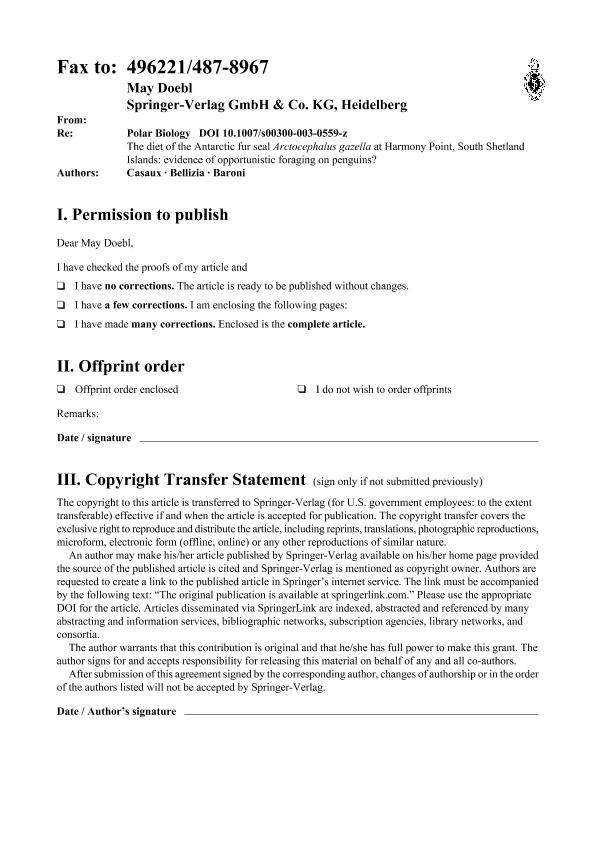Mostrar el registro sencillo del ítem
dc.contributor.author
Casaux, Ricardo Jorge

dc.contributor.author
Bellizia, L.
dc.contributor.author
Baroni, A.
dc.date.available
2017-11-17T18:20:18Z
dc.date.issued
2004-01
dc.identifier.citation
Casaux, Ricardo Jorge; Bellizia, L.; Baroni, A.; The diet of the Antarctic fur seal Arctocephalus gazella at Harmony Point, South Shetland Islands: evidence of oportunistic foraging on penguins?; Springer Verlag Berlín; Polar Biology; 27; 2; 1-2004; 59-65
dc.identifier.issn
0722-4060
dc.identifier.uri
http://hdl.handle.net/11336/28466
dc.description.abstract
The analysis of 523 scats collected at Harmony Point, Nelson Island, South Shetland Islands, from January to March in 2001 and 2002, indicated that the diet of non-breeding male Antarctic fur seals Arctocephalus gazella was diverse and composed of both pelagic and benthic-demersal prey. Overall, the Antarctic krill Euphausia superba and fish were the most frequent and numerous prey, followed by penguins, cephalopods (mainly squid) and gastropods. Myctophids represented 86.5% and 65.8% of the fish mass in 2001 and 2002 respectively, with Gymnoscopelus nicholsi being the main prey. Interestingly, penguin remains were present in 39.0% and 31.9% of the samples in 2001 and 2002, respectively and these birds were the main prey by reconstituted mass (74.0% and 76.1% in both seasons). The occurrence of penguins in the diet of A. gazella at Harmony Point is discussed in terms of the foraging strategy employed by seals and the temporal availability of prey.
dc.format
application/pdf
dc.language.iso
eng
dc.publisher
Springer Verlag Berlín

dc.rights
info:eu-repo/semantics/openAccess
dc.rights.uri
https://creativecommons.org/licenses/by-nc-sa/2.5/ar/
dc.subject.classification
Otras Ciencias Biológicas

dc.subject.classification
Ciencias Biológicas

dc.subject.classification
CIENCIAS NATURALES Y EXACTAS

dc.title
The diet of the Antarctic fur seal Arctocephalus gazella at Harmony Point, South Shetland Islands: evidence of oportunistic foraging on penguins?
dc.type
info:eu-repo/semantics/article
dc.type
info:ar-repo/semantics/artículo
dc.type
info:eu-repo/semantics/publishedVersion
dc.date.updated
2017-11-03T20:03:01Z
dc.identifier.eissn
1432-2056
dc.journal.volume
27
dc.journal.number
2
dc.journal.pagination
59-65
dc.journal.pais
Alemania

dc.journal.ciudad
Berlín
dc.description.fil
Fil: Casaux, Ricardo Jorge. Ministerio de Relaciones Exteriores, Comercio Interno y Culto. Dirección Nacional del Antártico. Instituto Antártico Argentino; Argentina. Consejo Nacional de Investigaciones Científicas y Técnicas; Argentina
dc.description.fil
Fil: Bellizia, L.. Ministerio de Relaciones Exteriores, Comercio Interno y Culto. Dirección Nacional del Antártico. Instituto Antártico Argentino; Argentina
dc.description.fil
Fil: Baroni, A.. Universidad de Buenos Aires. Facultad de Farmacia y Bioquímica; Argentina
dc.journal.title
Polar Biology

dc.relation.alternativeid
info:eu-repo/semantics/altIdentifier/doi/http://dx.doi.org/10.1007/s00300-003-0559-z
dc.relation.alternativeid
info:eu-repo/semantics/altIdentifier/url/https://link.springer.com/article/10.1007%2Fs00300-003-0559-z
Archivos asociados
